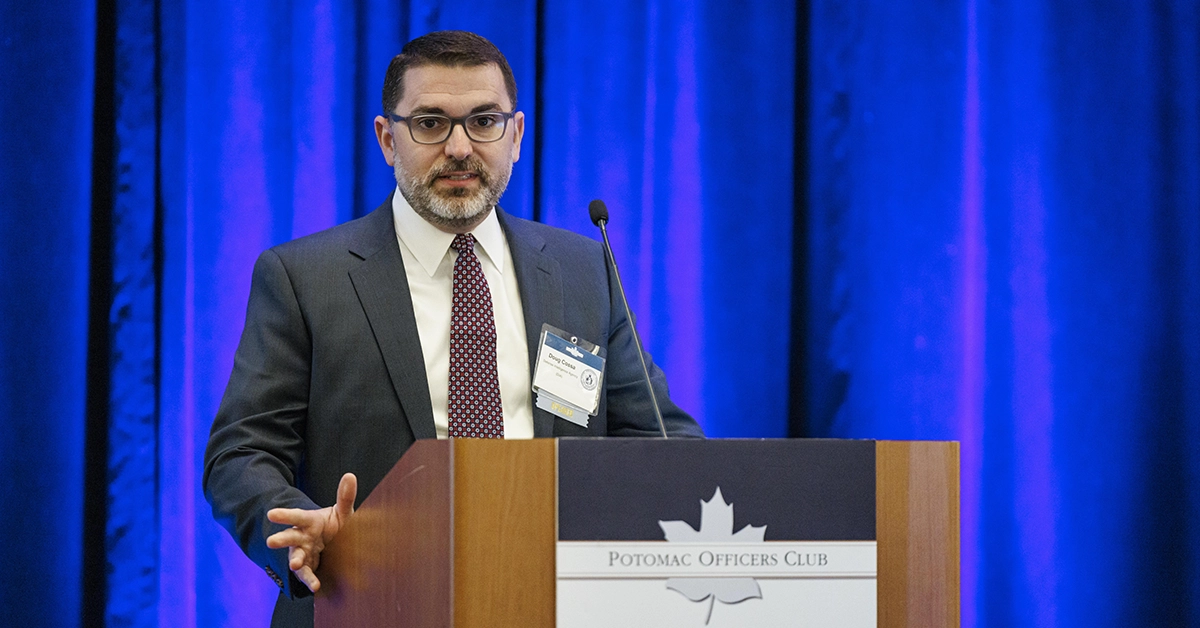Artificial intelligence has unlocked a myriad of threats and opportunities in the last two years with the acceleration of technological innovation in the AI space. Today, generative AI tools and large language models are still nascent and risky — but government leaders are seeing promise for the technology’s future.
Defense Intelligence Agency CIO Doug Cossa likened AI to a game of chess during his keynote speech at the Potomac Officers Club’s 5th Annual CIO Summit on Wednesday. Cossa said that AI and large language models should be used to uncover what we don’t yet know, not just for making existing tasks and processes easier or quicker.
“Where I see the biggest opportunity for AI, and especially with intelligence, is getting us to that ‘white space’ of identifying the opportunities that we’ve never seen before so we can actually then tip off our analysts, our collectors, to dive deeper into that,” said Cossa. “That’s where I see the biggest opportunity for AI — it’s not automating the status quo, it’s not automating what we already know.”
While AI is not specifically a focus area for Cossa, it is intertwined in many ways with the five priorities he outlined during his keynote.

JWICS
Cossa listed the Joint Worldwide Intelligence Communications System, known as JWICS, as his top priority.
“That is the wide area network for how we share information across the entire federal government. It’s over a million users,” he shared. “We tend to think of it in terms of just the IC or DOD, but the reality is, is any component of the federal government, whether it is industry, whether it is a domestic federal agency or whether it’s even a private entity, we provide TS/SCI network services on a wide area network.”
The DIA CIO revealed that when he first stepped into his role, the average age of JWICS equipment was 17 years old. Today, around 80 percent of that equipment has been refreshed, and now Cossa is focused on JWICS mobility and “what’s next” for the network, including software defined networking, automating network management and getting into the “AI realm.”
Desktop Environment
Cossa said he wants to expand the desktop environment, known as DTE, “so customers don’t need to think about how they, on a day-to-day basis, need to have the resources and the expertise to run a local area network.”
In this area, Cossa shared that DIA’s network cybersecurity has gotten much stronger since the agency launched its cybersecurity inspection program.
“I think collectively we’ve driven a lot of change in the community and focusing on getting the basics right when it comes to cyber,” he said.
International Systems
“If we’ve seen anything over the past few years — whether it’s been Russia-Ukraine or whether it’s been the most recent conflict this past October with Israel and Hamas — is connectivity with our partners is key,” Cossa urged. “Every one of these events depends on the information that we receive and share with our partners.”
Cossa said his role as CIO is providing the connectivity for those systems and integrating zero trust.
Mise en Place
The French cooking concept of “everything in its place” can also apply to information technology in the federal government, Cossa posited.
“For me, in the IT world, I look at myself as an infrastructure provider and as part of that, creating a capability delivery pipeline where we create a development, test and production environment on all fabrics for those that we support to where they don’t have to think necessarily about the data strategies and the cybersecurity and all the other standards that they need to incorporate,” he said.
“We often think about cybersecurity at the end of that process. I want to do it at the beginning. And that’s the direction that we’re headed in in DIA,” Cossa added.
Workforce
“One thing I’ve learned as CIO is that no tool is going to solve our problem. It’s the people that solve the problems at the end of the day,” said Cossa, “and that requires expertise to understand the environment and how things are connected in the environment. It brings me back to systems engineering. If you don’t understand the relationships between something and the interfaces, it will fail.”

Join POC’s next summit on June 6! The 2024 Cyber Summit brings together cyber experts and thought leaders from government and industry to share their thoughts on today’s most urgent cyber issues. Register here.
















